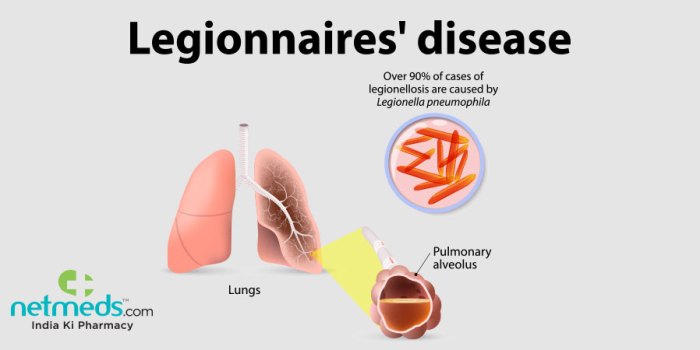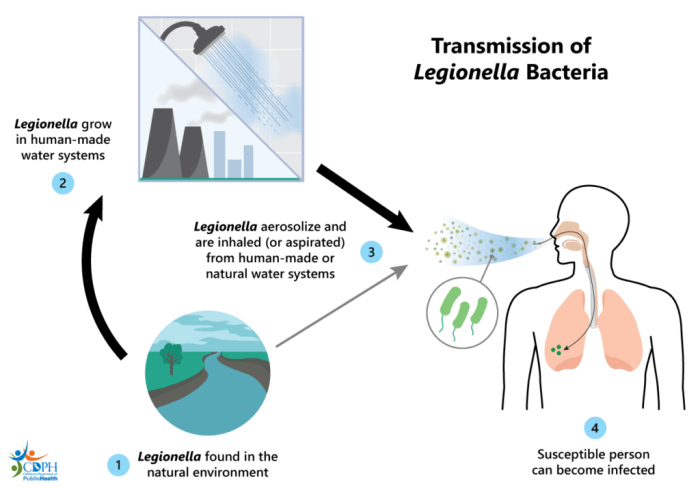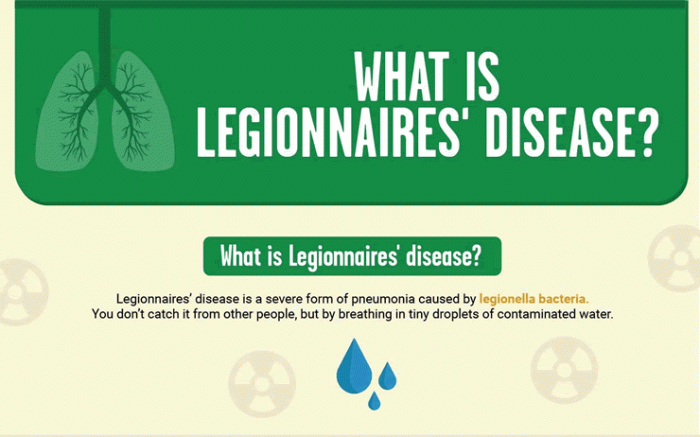Legionnaires’ disease, a potentially fatal lung infection, lurks in unexpected places, posing a threat to our health. This insidious disease has a complex history and transmission, leaving many vulnerable to its grip. Join us as we delve into the depths of Legionnaires’ disease, uncovering its causes, symptoms, and the measures we can take to protect ourselves.
Legionnaires’ disease is a severe form of pneumonia caused by Legionella bacteria, which thrive in warm, stagnant water. It was first identified in 1976 during an outbreak at an American Legion convention, hence its name. The disease can range from mild to life-threatening, with symptoms including fever, chills, cough, and muscle aches.
Definition and Overview
Legionnaires’ disease is a severe form of pneumonia caused by the bacterium Legionella pneumophila. It is typically contracted by inhaling aerosolized water droplets containing the bacteria. The disease was first identified in 1976 during an outbreak at an American Legion convention in Philadelphia.
Transmission and Risk Factors: Legionnaires’ Disease
Legionnaires’ disease is transmitted through the inhalation of aerosolized water droplets containing Legionellabacteria. Common sources of infection include cooling towers, evaporative condensers, hot tubs, and showerheads. Risk factors for developing the disease include age (over 50), underlying health conditions (e.g., chronic lung disease, diabetes), and exposure to contaminated water sources.
Symptoms and Diagnosis

Symptoms of Legionnaires’ disease include fever, chills, cough, muscle aches, and headache. The disease can be diagnosed through laboratory tests that detect the presence of Legionellabacteria in the urine or respiratory secretions. Imaging techniques, such as chest X-rays or CT scans, may also be used to confirm the diagnosis.
Treatment and Prevention

Treatment for Legionnaires’ disease typically involves antibiotics and supportive care. Antibiotics are used to kill the bacteria, while supportive care may include oxygen therapy, intravenous fluids, and pain relievers. Prevention measures include proper water management and disinfection practices in buildings and facilities where Legionellabacteria may be present.
Epidemiology and Public Health Implications

Legionnaires’ disease is a reportable disease in many countries. The incidence of the disease varies worldwide, with higher rates reported in areas with warm climates and aging populations. Public health measures taken to control and prevent outbreaks include surveillance, outbreak investigations, and the implementation of water management guidelines.
End of Discussion
Understanding Legionnaires’ disease is crucial for safeguarding our health. By implementing preventive measures, such as proper water management and disinfection practices, we can minimize the risk of infection. Early diagnosis and treatment are also essential for a favorable prognosis. As we continue to unravel the complexities of Legionnaires’ disease, we empower ourselves to protect our communities from this potentially devastating infection.
Helpful Answers
What are the common sources of Legionella bacteria?
Legionella bacteria can be found in warm, stagnant water sources, such as cooling towers, hot tubs, and poorly maintained plumbing systems.
Who is most at risk of developing Legionnaires’ disease?
Individuals over the age of 50, smokers, and those with weakened immune systems are at an increased risk of developing Legionnaires’ disease.
How is Legionnaires’ disease diagnosed?
Legionnaires’ disease is typically diagnosed through a combination of laboratory tests, such as urine antigen tests, and imaging techniques, such as chest X-rays.